 |
| mohamed elhassan abdelatif mahir / courtesy muawia shaddad and peter jenniskens |
| About 40 minutes after the meteor’s explosions, Mohamed Elhassan Abdelatif Mahir took this photograph in Wadi Halfa using his mobile phone. The cloud is what astronomers call the meteor’s “dust train.” |
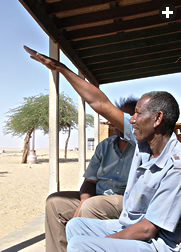 |
| Eyewitness to the explosion of 2008 TC3, station attendant Abdel Moneim Magzoub points out the altitude of the fireball to Muawia Shaddad of the University of Khartoum. |
 arred awake by a thunderous explosion, Abdel Moneim Magzoub sat bolt upright in his sleeping cot on the porch of Station 6, the railway stop in northern Sudan where he worked as an attendant. It was just before dawn on October 7, 2008. His heart pounding, he woke in time to see a fireball careening through the sky and explode a second time, leaving a glowing cloud. He had no idea what he had just seen.
arred awake by a thunderous explosion, Abdel Moneim Magzoub sat bolt upright in his sleeping cot on the porch of Station 6, the railway stop in northern Sudan where he worked as an attendant. It was just before dawn on October 7, 2008. His heart pounding, he woke in time to see a fireball careening through the sky and explode a second time, leaving a glowing cloud. He had no idea what he had just seen.
Astronomer Richard Kowalski, monitoring the night skies from the summit of Mount Lemmon, near Tucson, Arizona, less than 24 hours before, knew exactly what Magzoub saw. Kowalski tracks asteroids. He had monitored the white blip that crossed his screen at 6:39 that morning and forwarded its coordinates to the Minor Planet Center (mpc) in Cambridge, Massachusetts.
In California, astronomer Steve Chesley was getting his kids off to school around 7:30 a.m. when a call from mpc director Tim Spahr sent him hustling to his office at the Jet Propulsion Laboratory (jpl) in Pasadena: A “potentially hazardous asteroid” was headed for Earth. Chesley’s job was to estimate where and when it would strike. “We were able to confirm that it was a small asteroid, no more than a few meters in diameter,” says Chesley, who had run through this scenario with his colleagues many times before—but always only hypothetically.
Spahr also called Lindley Johnson, program executive at Near Earth Object Observations in Washington, D. C. “We’ve got one,” Spahr told him.
“How big is it?” Johnson immediately wanted to know.
Within an hour, Chesley and colleagues Paul Chodas and Don Yeoman had calculated that the asteroid, named 2008 TC3, would enter Earth’s atmosphere over the Nubian Desert in northern Sudan, where the local time would be 5:46 a.m. It would track a roughly west-to-east course, some
100 kilometers (62 mi) south of the Egyptian border. That prediction was passed back to the mpc, forwarded to the headquarters of the National Aeronautics and Space Administration (nasa) and circulated to networks of astronomers around the world.
 |
| Some 45 students and staff of the University of Khartoum, led by physicist Muawia Shaddad (top row, sixth from right) and guided by astronomer Peter Jenniskens, made several trips to the area to search for fragments of the asteroid. Below, Right: Imaging from Meteosat 8 caught the location of the fireball west of Almahata Sitta (Station 6). The arrow shows its direction of travel from entry into the atmosphere, its explosion and its dispersal. |
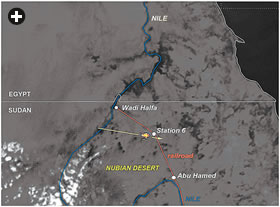 |
 n the early morning hours of October 7, Captain Ron de Poorter was at the controls of KLM flight 591, passing over the desert of eastern Chad en route from Johannesburg to Amsterdam. A few weeks from retirement, he was anticipating his next motorcycle safari in South Africa when he received a radio transmission that had originated with Jacob Kuiper, an amateur meteor astronomer and aviation meteorologist at the Royal Netherlands Meteorological Institute. Following Kuiper’s advice, as the early signs of sunrise were appearing, de Poorter and his co-pilot dimmed the cockpit lights and looked to the northeast. At exactly 02:45:40 Universal Coordinated Time, he says, a pulsating red-and-yellow light glowed on the horizon for about five seconds. “It looked like distant artillery or rocket fire,” says de Poorter, who called it “a very nice retirement gift.”
n the early morning hours of October 7, Captain Ron de Poorter was at the controls of KLM flight 591, passing over the desert of eastern Chad en route from Johannesburg to Amsterdam. A few weeks from retirement, he was anticipating his next motorcycle safari in South Africa when he received a radio transmission that had originated with Jacob Kuiper, an amateur meteor astronomer and aviation meteorologist at the Royal Netherlands Meteorological Institute. Following Kuiper’s advice, as the early signs of sunrise were appearing, de Poorter and his co-pilot dimmed the cockpit lights and looked to the northeast. At exactly 02:45:40 Universal Coordinated Time, he says, a pulsating red-and-yellow light glowed on the horizon for about five seconds. “It looked like distant artillery or rocket fire,” says de Poorter, who called it “a very nice retirement gift.”
At jpl, Chesley and his colleagues were thrilled. “It was the perfect test of our system,” says Chesley. “The prediction was accurate.”
Traveling at more than 12.4 kilometers per second (28,000 mph), 2008 TC3’s collision with Earth’s atmosphere produced three explosions. The second one, at 37 kilometers (23 miles) altitude, was estimated to be equal to the pressure of about one kiloton of tnt. (The first and third explosions, at 42 and 35 kilometers up, respectively, were smaller.) Too high to cause damage on the ground, the explosions turned most of the asteroid’s mass into a giant dust cloud, while the surviving fragments fell over some 210 square kilometers (81 sq mi) of barren desert.
At the Search for Extra Terrestrial Intelligence (seti) Institute in California, Peter Jenniskens, an expert on meteor showers, knew that the chances of finding fragments of the meteor were slim at best. But if eyewitnesses had seen parts of it continue deeper into the atmosphere, then that, he reasoned, could lead to the recovery of fragments—meteorites.
 He contacted the University of
Khartoum in Sudan, where he made the acquaintance of Muawia Shaddad, an astronomer in the department of physics. Shaddad then located Abdel Moneim
Magzoub, the attendant in Station 6, as
well as two other eyewitnesses, one of whom had taken photos of the dust cloud on his cell phone.
He contacted the University of
Khartoum in Sudan, where he made the acquaintance of Muawia Shaddad, an astronomer in the department of physics. Shaddad then located Abdel Moneim
Magzoub, the attendant in Station 6, as
well as two other eyewitnesses, one of whom had taken photos of the dust cloud on his cell phone.
Jenniskens flew to Khartoum in December 2008, where he joined Shaddad in collecting observations from eyewitnesses in hopes of determining how deep the remains might have penetrated. At the university, more than 40 enthusiastic students and staff responded to Shaddad’s call for volunteers to join in a search. Saadia Elsir, a doctoral student in meteorology who teaches at Sudan’s Juba University, was a member of the organizing committee. “I was eager to get involved,” says Saadia, who eventually found a dozen meteorites and has co-authored a paper on the recovery.
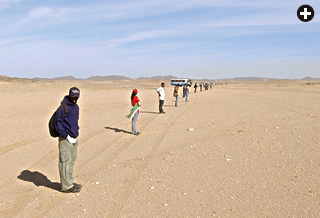 |
| Students lined up to search the desert floor for meteorites. |
Following a 14-hour drive from the capital, the searchers arrived at Station 6, an isolated railway station, truck stop and teahouse. There, they split into groups and lined up 20 meters (65') apart. They began to comb the open desert along the meteorites’ predicted path, with instructions to call out if they sighted any small black rocks.
Physics student Hiba tag Elsir was near fellow student Mohammed Alameen when she heard him shout, “I found one!” Having heard a few false alarms already, Jenniskens had his doubts, but after a close look, “I knew right away that it was a meteorite that had recently fallen,” he says. He joined the students in a spontaneous celebration of the find. “It was a rich, black color, and it had the thin, glassy surface that forms as a result of melting and solidifying.”
 |
| Two hours later Mohammed Alameen sighted an unusual-looking black rock—the first of what now total 280 meteorites recovered to date. |
Gamely putting up with flat tires, sandstorms and getting stuck in the sand, subsequent search expeditions have recovered more than 600 meteorites from 2008 TC3. Nonetheless, these comprise but a fraction of the asteroid’s original estimated 88-ton weight. Nada Mohamed Agabna, a graduate student in physics at the University of Khartoum, found her first two fragments on the second expedition. “It makes you feel so happy to actually hold something that came from outer space,” says Nada, who later helped out on two more expeditions. (On one trip, even the bus driver found a fragment.)
“Every find brings another adrenalin rush,” says Jenniskens, who was lucky to find the biggest of the lot—a piece that weighed
379 grams (13 1⁄3 oz). The smallest fragment recovered weighed
0.3 grams, or 1⁄100 th of an ounce.
Detailed studies of the meteorites, which have been collectively named Almahata Sitta (from the Arabic for “Station 6”), carry significant implications for space research, and they promise to shed light on our early solar system 4.5 billion years ago. In particular, scientists are finding their geological composition intriguing.
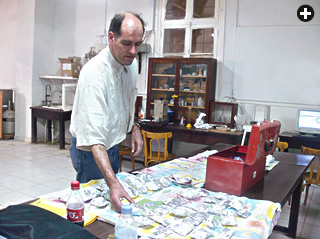 |
| With each meteorite wrapped in aluminum foil to prevent contamination, Jenniskens catalogued each one in preparation for study. |
At Stanford University, Hassan Sabbah and graduate student Amy Morrow, who research oil composition, have found in the meteorites evidence of polycyclic aromatic hydrocarbons (pahs), which on Earth are commonly produced through incomplete combustion of fossil fuels. Does this mean asteroids might have something in common with Earth’s fossil fuels?
“That’s what we want to find out,” says Sabbah: “How to relate pahs in space to those on Earth.”
“These meteorites fell in the best region possible,” says Morrow, who found several fragments herself. “There’s a very low risk of contamination out there.”
2008 TC3, it turns out, is a rare asteroid known as an “F-type,” which comprises less than four percent of the asteroid belt that lies mostly between the orbits of Mars and Jupiter. The meteorite fragments of 2008 TC3 are classified as ureilite, and these are more rare still—they make up only 0.6 percent of recorded meteorite falls. Along with the amino acids and various minerals they contain, the unusually porous samples from 2008 TC3 are beginning to reveal a fascinating history.
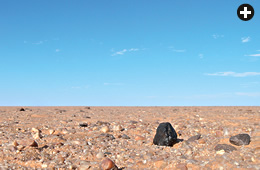 |
| This meteorite was the 15th found by the group. It was photographed in its landing spot before recovery. |
“From what we can decipher,” says nasa scientist Michael Zolensky, “the original asteroid only partially melted, was blasted apart by an impact with some other asteroid or comet, and then reassembled into a second-generation asteroid.” Zolensky says the meteorites probably came from the asteroid’s surface, because many show evidence of interactions with the space environment and even include pieces of other asteroids.
The retrieval and study of the Almahata Sitta meteorites now offers further insight into asteroid formation. For the first time, a meteorite on Earth can be linked to its asteroid source. “For the more than 40,000 meteorites already in our collection, we know general origin only, nothing specific,” says Jenniskens.
“So this is like a low-cost space mission,” he says with enthusiasm. “For the first time, we have collected a sample from a celestial body that we knew as an asteroid in space.”
http://asima.seti.org/2008TC3/
 |
Ann Chandler (www.annchandler.com) is a freelance writer and editor who writes on anthropology and archeology. A member of the Professional Writers Association of Canada and the American Society of Journalists and Authors, she lives near Vancouver and has just published her second novel. |